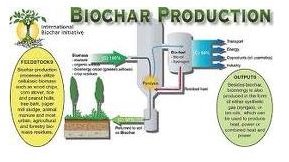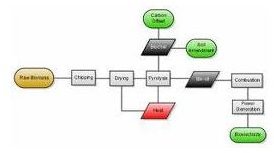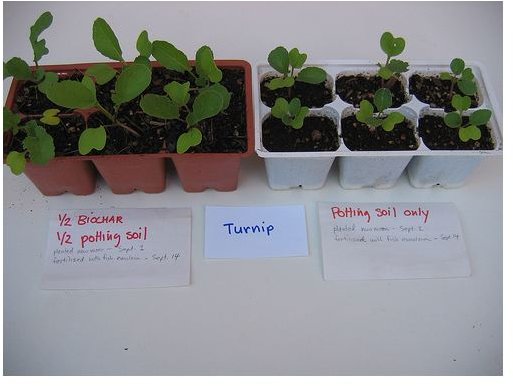Biochar Benefits - A Greener, Carbon Neutral Alternative for making Biofuels and Being Good Earth Stewards
Biochar vs. Charcoal - A Greener Alternative for Renewable Energy
People in rapidly developing countries face the problems of domestic energy requirements, and this will force increased deforestation, which leads to desertification, drought, and, in extreme cases, famine. Based on current studies, more than 12% of the world’s human-produced greenhouse emissions could possibly be offset by using biochar to amend soil condition and sequester carbon, at the same time or after using charcoal- for low-tech burning and cooking- or preferably switching to clean renewables such as biogas (syngas).
The study also reported that using plant clippings for biochar offsets more carbon than if the same plants and resources were burned to make bioenergy. Moreover, biochar will help in increasing food production as it increases the fertility of the soil.
The desired quality of biochar is that it is a naturally stable carbon sink, but it also increases the fertility of the soil and improves the water preservation ability and soil cat-ion exchange. This eventually increases crop productivity and yield. The decisive goals for producing biochar are that it persists as solid carbon preservation and it can be either used as a feedstock or fuel (through the gasification processes to make syngas).
Image: An experiment that compares turnip seeds sprouted in commercial potting soil, compared to a mix of half potting soil and half biochar. The biochar was made with a pyrolyzing cook stove.
Biochar Production Rates
An example of a biochar production facility would be a large-scale pyrolysis unit that operates up to 7,000 hours per year and processes up of 2 dry tons in a hour. Roughly, this pyrolysis unit will use 8,000 to 15,000 tons of dry biomass feedstock and 15,000 to 30,000 tons of wet stocks in a year. With available materials, the plant could potentially produce around 2,500 to 4,500 tons of biochar in a year and this would contain 1,200 to 2,400 tons of carbon. The sequestered carbon in the form of biochar will exhibit a long term stability after it is been applied to a field.
Potential Income from Production of Biochar
From the farmer’s point of view, potential income will come from three sources:
- Amendment of the soil, moderately offsetting the need for fertilizers
- A source of heat gasses and bio-oil from field and ranch land use
- As a carbon counteraction in a future cap and trade market
Economic Tradeoff between Biochar and Bio-oil Production via Pyrolysis
Various researches and case studies reported that:
- For any given temperature, slow pyrolysis is estimated to provide more biochar and less bio-oil compared to fast pyrolysis.
- Bio-oil yield increases with temperature for low temperatures, and then it hits a peak and begins to decline. Biochar declines over the entire range.
- Tradeoff at low temperatures: biochar yield ↓; bio-oil yield ↑. Optimal temperature depends on the relative prices of the two products.
- At higher temperatures both yields decline. Production at and above the temperature where bio-oil yields begin to decline is uneconomical.
Cost and Values of Biochar Production
The cost and values of biochar production still needs research and study. There are many issues and debates about the production cost. Washington State University recently published a study in which it provides estimates of the non-farm ranch based production cost of biochar (Granatstein et al., 2009). The study was based on biomass from sustainable forests, and a wide range of production costs were found for biochar and bio-oil. The study reveals that total production cost of biochar of between $194 and $424 for each feedstock ton.
Moreover, there are a number of private carbon offsets available in the market, and none of them have institutionalized carbon offset related to biochar. The United States in late 2009 announced that it would provide loan guarantee programs with an aim to support the biochar production demonstration market. There are many studies which revealed the estimated biochar production, but once again they are highly depended on the life-cycle greenhouse gas emission estimates and price expectations of the future unknown price of carbon.
Waste Sources Available as Pyrolysis Feedstock
Some sources of biomass include clippings and yard waste biomass, including that which is composted, waste from green houses, and the animal bedding from polo barns.
Roberts estimated the cost of transportation and collection (15 km) of the possible feedstock in the range of $30 to $45 ton with the final cost of $240 to $310 per ton CO2e (CO2 equivalent) confiscated in biochar (Roberts, 2009). However the final syngas and biochar will also have value, and this will reduce the cost of production.
Biochar production total cost, with a presumptive low value for carbon of $3.38/ton CO2 and a conservative estimate on the electricity produced from the syngas, ranges from $100 to $230 per ton CO2e confiscated and depends on the feedstock used. However, if carbon is valued at a higher rate ($80/ton CO2e), biochar has a production cost of $40 to $150 per ton CO2e confiscated, again depending upon the feedstock used.
Conclusion
Biochar is found to have potential as a soil amendment for a variety of uses, and its value would likely increase as social and regulatory interest in carbon sequestration increases. Using biochar as an energy source will thereby help in offsetting the use of fossil fuels for energy, and soil amendment and its potential carbon sequestration benefits for agricultural uses.
“There is one way we could save ourselves and that is through the massive burial of charcoal. It would mean farmers turning all their agricultural waste- which contains carbon that the plants have spent summer sequestering- into non-biodegradable charcoal, and burying it in soil.”- James Lovelock.
Biochar Production and Potential Income Source from Biochar Production


Further reading: Making Biochar - Small to Large Scale Production of Biochar from Biomass, provides information about the different processes that can be used to produce biochar. These include thermal decomposition by slow and fast pyrolysis using equipment suitable for home processing or medium and large commercial ventures that also produce biofuel. Some of them are even mobile and can go to the fields and farms where the biomass that needs converting actually is.
References
- Cornell University Agricultural Experiment Station (CUAES), February 5, 2009
- Communication, Lewis, Andrew, Director of Operations, telephone conversation with Andrew
- Murphy, Cornell University Environmental Compliance and Sustainability, Ithaca, NY.
- Roberts, K. G.; Joseph, J.; Gloy, B.; Lehmann, J., Life cycle assessment of biochar production:
- Estimating the energetic, economic, and climate change potential. In preparation 2009
- Granatstein, D., et al. 2009. FINAL REPORT: Use of Biochar from the Pyrolysis of Waste Organic Material as a Soil Amendment. Center for Sustaining Agriculture and Natural Resources. Washington State University. Granatstein, D., et al. 2009. FINAL REPORT: Use of Biochar from the Pyrolysis of Waste Organic Material as a Soil Amendment. Center for Sustaining Agriculture and Natural Resources. Washington State University.
- Image: Experiment of Turnip Production Using Biochar
